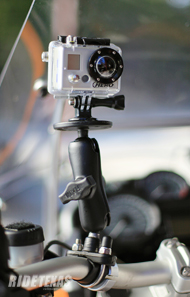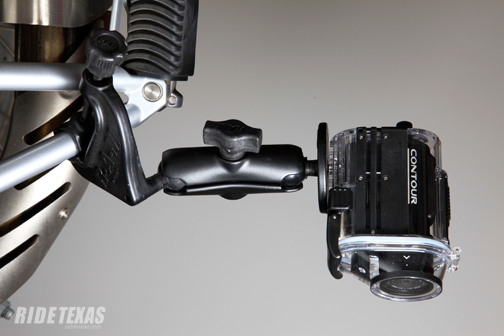

- Words & photographs by Wayne Roth

We are living in an era of rapidly evolving multimedia. Digital cameras are ubiquitous and built into nearly every cell phone. Most also capture video. Wide-screen high definition televisions are widely available, and many will show movies in 3D. With some widely available tools, anyone can make a motorcycle movie.
The Resolution Evolution
High Definition (HD) television is usually broadcast in one of two formats: 720p30 or 1080i30. The first number represents the count of vertical photo elements (pixels). HD sets are wider than tall and have horizontal resolutions of 1920 or 1280 pixels, respectively. For reference, older TVs had a maximum resolution of 480 vertical and 330 horizontal lines. The “p” nomenclature stands for progressive, and “i” for interlaced video. Progressive means each frame is a different picture. The interlaced format takes two frames to display an image and fast moving subjects tend to smear, so it’s best to stick with progressive. The second number, if shown, indicates the number of video frames per second (fps). The standard rate for HD video is 30 fps, although 24 fps videos are often produced to look more like legacy film movies.
Generally, the more frames per second, the smoother the motion. 720p60 is a very good action format, and 1080p60 is even better, but the latter requires so much image processing power that it’s currently out of reach for most non-commercial use.
Consumer camcorders have tracked with the image resolution race, and most current digital still cameras are capable of recording 720p or 1080p video.
Cameras
A sports enthusiast line of small HD cameras have become available in recent years and are well suited for motorcycle movie making. The GoPro HD, GoPro HD2, Contour Roam, and Contour GPS cameras record video at 1080p30 or 720p60 resolution and can alternately capture a continuous stream of still pictures. The Contour GPS incorporates a GPS receiver that embeds position, altitude, and speed in the captured video stream. It also transmits video via Bluetooth to a suitably equipped Apple or Android phone for camera pointing. GoPro sells an LCD viewscreen for the camera back, and is working on a Wi-Fi remote video controller. GoPro also makes a two-camera enclosure that lets you capture 3D videos, although I’ve found the sensation of depth diminishes significantly beyond 20 to 30 feet from the camera. iPhone 4 and 4s cellphones take excellent 1080p videos. A new Austin-based startup, Optrix, sells a rugged iPhone 4 case and mounting system specifically suited to outdoor applications.

Shooting The Video
Whatever camera you chose, you need to be aware that vibration can be a problem. Some cameras employ image stabilization to counter handheld shake, but the correction isn’t good enough to cancel out engine-induced pulsations. If your mirrors vibrate, it’s likely your video will, too. Clamp mounts with camera compatible ¼-20 threads are available from Ram Mount, and the larger Manfrotto “Super Clamp” has jaws wide enough to clamp on fork tubes. Try placing the camera at various positions on your bike to find the spot with the least vibration.
GoPro, Contour, and Optrix sell helmet or chest mounts for their cameras. These mounts, in addition to making possible image capture from a rider’s perspective, help improve video quality by effectively isolating the camera from engine vibration. However, Ride Texas® does not consider these mounts safe for motorcycle riders and discourages their use. Attaching any device, no matter how small, to any part of the rider will change, in unpredictable ways, the dissipation of impact forces in case of an accident and increase the likelihood of serious injury.

The Editing Room
A five-year old Pentium 4 computer isn’t going to edit, or likely even play smooth video from an HD camera. At least a dual-core 3 Gigahertz processor with a fast video card is required to edit HD video. Fortunately, market prices typically remain flat as PC’s get faster, and this level of PC can be obtained for $500 to $600. Apple computers and software programs tend to be easier to use for photo and video editing, but expect to pay a hefty premium for similar processing power.
You’ll also need editing software. The free Windows Live Essentials Movie Maker and Apple iMovie will handle basic video editing. Sony Vegas Movie Studio HD and Cyberlink PowerDirector 10 are very capable PC applications ranging in cost from $50 to $130 depending on options. For the Mac, Final Cut Pro X is a big step up from iMovie in terms of features, but will set you back $299. These programs can directly upload finished video to popular hosting sites, although the sites themselves now have web tools that make uploading easy.
Here are a few editing tips to maintain audience interest. Keep your movies short. If videos are over 2 or 3 minutes long, they’d better be action packed! Shoot from different camera angles. Try footage from a low camera clamped to a foot peg showing the road whisking by interspersed with a higher point of view. Throw in a few shots looking back at you from a windshield mounted camera. Then put the camera on a small tripod at road level and ride on by. If you’re in a group, you can toss in a few short clips of the riders ahead and behind. Mix it up. Add a music track from a royalty free computer program like Sonicfire, or even play your own instrument.
Since consumer HD cameras and editors have become commonplace, creating professional looking movies is easy and a lot of fun. Riders all over the world are producing very cool motorcycle flicks. On Any Sunday, 2012? Watch out Bruce Brown, you may have some competition.
This article originally appeared in the Volume 14 No2 edition


